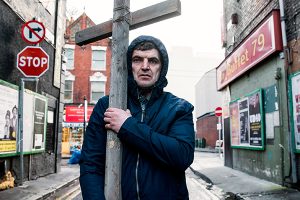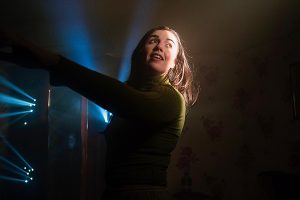THEATRE EYE: Sunder
Published in
Issue 4 (July/August 2016),
Reviews,
Volume 24
ANU Productions
Moore Street, Dublin 1, 19 April–7 May 2016
By the time this review appears, the centenary commemoration of the Easter Rising will have been and gone, and in time will surely join other commemorative initiatives—such as the 150th anniversary of the Famine and the bicentenary of 1798, and indeed the 50th anniversary of the Rising itself—that have since become meat and drink to historians. In 2016 the advent of digital technology and social media has added to the deluge of printed commentary that accompanied the centenary; indeed, at times it has been difficult for even interested parties with the best will in the world to keep on top of the sheer volume of books, articles, documentaries, dramas, on-line resources and blogs that have been developed. These will naturally be raw material for our future historians. What will not be so easily studied are those initiativesthat depended upon active and subjective participation, such as ‘Proclamation Day’, the vast number of community projects and re-enactments, and, of course, the unique dramatic works of ANU Productions, who have produced what is easily one of the most striking interpretations of 1916 in the form of Sunder.

Above: Sunder takes the form of an almost surreal journey around what is by now the most famous of the 1916 battle sites: Moore Street and environs.
is the first of what is intended to be a triptych of works to be presented in 2016, and takes the form of an almost surreal journey around what is by now the most famous of the 1916 battle sites: Moore Street and environs. It begins outside the ILAC Library, as the audience of four are told to keep an eye out and await instructions, which come via a young man who appears from nowhere with a hurley and gives everyone a mobile phone with which to take a call. And so it begins, as, following instructions, the production goes out onto Moore Street.A key theme of
Sunder is the presence of a hidden history that remains around us, in this case the desperate and intense fighting that brought the Easter Rising to an end in the terrace of houses on the east side of Moore Street—or, in its 2016 incarnation, an Asian fast food restaurant. There we meet the young man from the opening, who is revealed to be Seán McLoughlin, the young Volunteer from the northinner city who led his colleagues out of the burning GPO—one of a troika of real-life characters (including James Connolly’s secretary, Winifred Carney, and the London-born Volunteer Joe Good) who bring the tiny audience around the surviving lanes around Moore Street and the street itself. None would look amiss on the Moore Street of 2016 (bar Joe Good’s vintage Ireland jersey).

Above: Seán McLoughlin, ‘Commandant General of the Irish Republic’ (Craig Connolly), in an Asian fast-food restaurant.
defies easy description; it drags in its audience in casual yet unsettling ways, from McLoughlin’s offer of chips and prawn crackers to Carney and Good’s attempts to encourage an imitation of James Connolly’s Scottish accent. The tour of Moore Street is very much of a piece with ANU’s approach in other productions, where a previous reality is initially conjured up on site, oblivious of the contemporary reality around it, but is then interspersed with disorienting shifts between past and present.
Sunder then moves indoors into nightmarish territory, as the audience is ushered into the back of a supermarket and upstairs (by a German-speaking actor) into two rooms: one occupied by two prone characters, seemingly daubed in mudand presumably dying slowly,and the other by a more conventional dramatic scene in a ruined tenement, which unfolds with disconcerting intensity before all is brought to a sudden and unexpected conclusion that returns the audience—who are expected to participate—back into the reality of 2016.

Above: A tenement under attack—the nightmarish end of Sunder makes an attempt to conjure up the horrors of war as it came to the inhabitants of Moore Street at Easter 1916.
(All images: ANU/Pat Redmond)
The sheer intensity of this dramatic spectacle may well prove unsettling to those who take part (and elements of it certainly caught the attention of bemused passers-by). There is a hallucinatory, disturbing quality to
Sunder, with an emphasis on civilians and the human cost of the Rising. The attention lavished on Moore Street by campaigners aiming to save it from developersin recent years dwelt upon its status as almost the Alamo of the Rising, the last HQ of the ‘Provisional Government’. But the occupation of Moore Street came at a cost, which was paid by innocent civilians living there. Relatively few people fought in the Rising but far greater numbers were affected by it, and in the centenary year they have finally, and belatedly, been accorded a role in the story of Easter Week. Moore Street saw extremely heaving fighting in a confined area, as Volunteers broke into terraces on the east side of the street and smashed through walls seeking an escape route. The casualties in the area arose from the intensity of the fighting, as there was a British barricade firing from the other end of the street. Pearse’s decision to surrender was influenced by the killing of civilians on Moore Street, and while SeánMcLoughlin never had the chance for a death-or-glory charge against the British barricade, the decision to surrender also ensured that a British plan to storm the houses on the street never happened either. The nightmarish end of
Sunder, taking place amongst the bereaved and traumatised, makes an attempt to conjure, in impressionistic and naturalistic style, the horrors of war as it came to the inhabitants of Moore Streetat Easter 1916. It is not, strictly speaking, documentary theatre in that sense, but the evocation of chaos has a disorientating power that gives a hint of an element of the experience of the Rising that has been hidden in plain sight in recent times.When leaving the production, a glance back towards the ILAC centre revealed the actor who played Good leading two more people into the shop; unless you knew what they were doing, they would simply be three more people amidst the bustle of Moore Street, which is perhaps a neat way of encapsulating what the production is about.
Sunder had a relatively limited run, but readers interested in how 1916 played out on the streets of Dublin might be interested in a new blogestablished by UCD and Dublin City Council. The Archaeology of 1916 is spearheaded by Franc Myles (who oversaw the archaeological investigation of 14–17 Moore Street) and attempts, through both fieldwork and documentary research, to examine the traces of the Easter Rising that remain in Dublin’s streetscape. It is a fascinating and very accessible project, well worth exploring whether one has seen Sunder or not: https://thearchaeologyof1916.wordpress.com.
John Gibney is Glasnevin Trust Assistant Professor of Public History and Cultural Heritage at Trinity College Dublin and the author of A history of the Easter Rising in 50 objects.



















